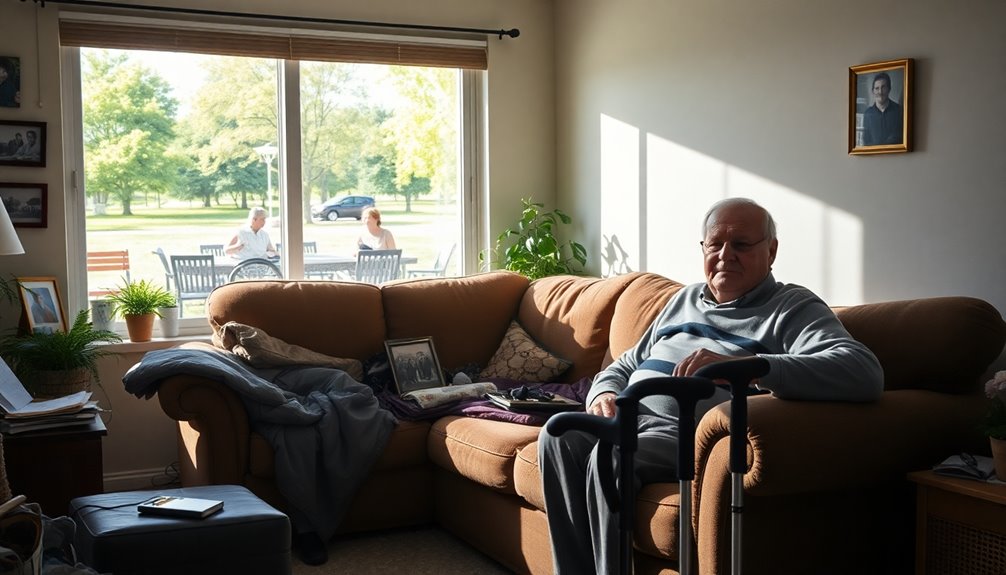Aging at home might sound great, but it comes with significant challenges. Safety hazards, like poor lighting and loose railings, can increase risks. Limited access to healthcare often affects rural areas, while the burden on informal caregivers is overwhelming, leading to stress and health issues. Plus, social isolation can worsen without community support. If you think home is the best, you might want to reconsider and explore the complexities involved. There's much more to uncover.
Key Takeaways
- Aging at home presents safety challenges, with 90% of older adults needing modifications for a secure environment.
- Home care can still be costly, averaging $28,080 annually compared to $108,405 for nursing homes.
- Informal caregivers often face significant economic and health burdens, which can strain family dynamics and overall well-being.
- Community-based services are essential for combating social isolation and enhancing the quality of life for seniors.
- Future demands for long-term care are increasing, making home-based care insufficient without adequate support and resources.
The Reality of Aging at Home
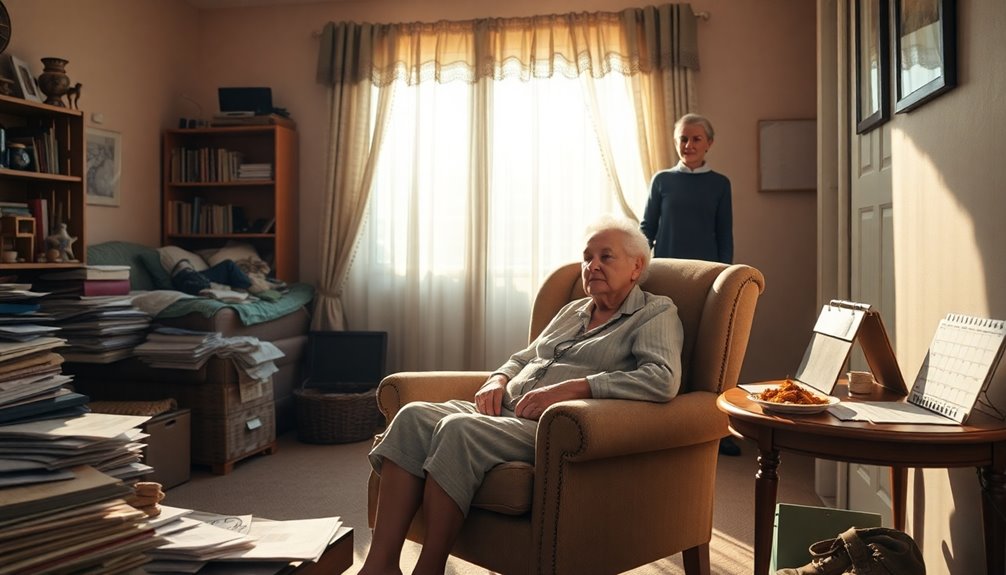
As you consider the reality of aging at home, it's important to acknowledge the unique challenges that come with it. Safety concerns, like poor lighting and loose railings, can pose serious risks. Most homes lack necessary modifications, making it difficult for about 90% of older adults to age safely in place. Additionally, many families are now hiring migrant caregivers to help manage these challenges.
Accessing healthcare can be a struggle, especially in rural areas, and social isolation can creep in without family or community support. Additionally, home modifications and care services can strain your finances. While informal caregivers, like family and friends, can offer help, the emotional and physical demands on them can be overwhelming. Balancing these challenges is crucial for maintaining your independence and well-being as you age.
Understanding the Costs of Home Care vs. Institutional Care
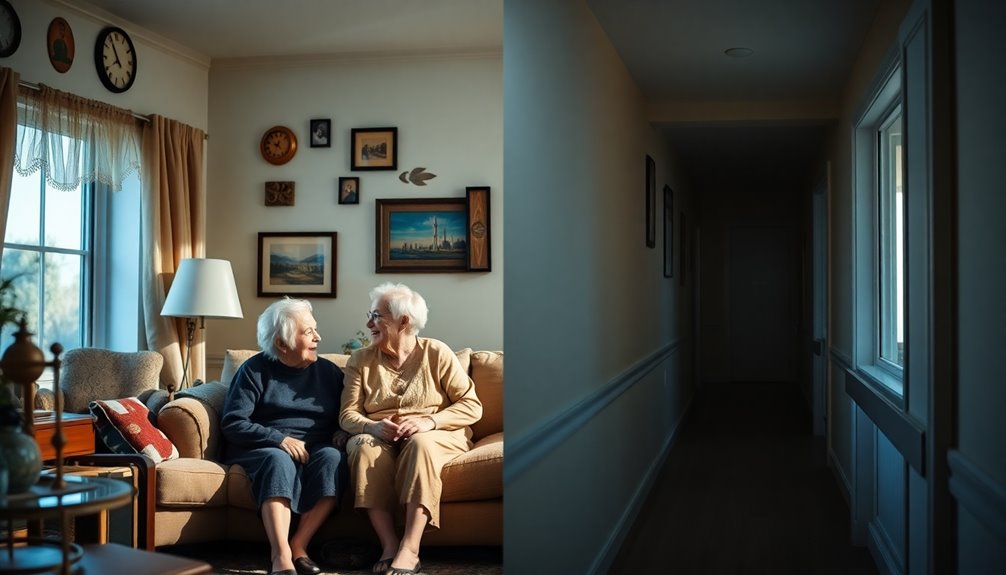
When weighing your options for care, understanding the costs associated with home care versus institutional care is crucial.
Home care can be less expensive, especially if you're only needing limited hours. For instance, 20 hours of home care per week averages around $28,080 annually. However, informal caregiver time can dramatically influence overall costs. Additionally, home care can be more affordable with limited hours compared to full-time care options. Indexed annuities can help provide financial stability to cover unexpected care expenses.
On the other hand, institutional care, like nursing homes, typically runs about $108,405 a year for a private room. Assisted living isn't cheap either, averaging $5,511 monthly.
Your decision should consider your health needs, financial situation, and the availability of informal caregivers. Planning ahead is essential to ensure you can afford the care you need, whatever option you choose.
The Importance of Community-Based Services
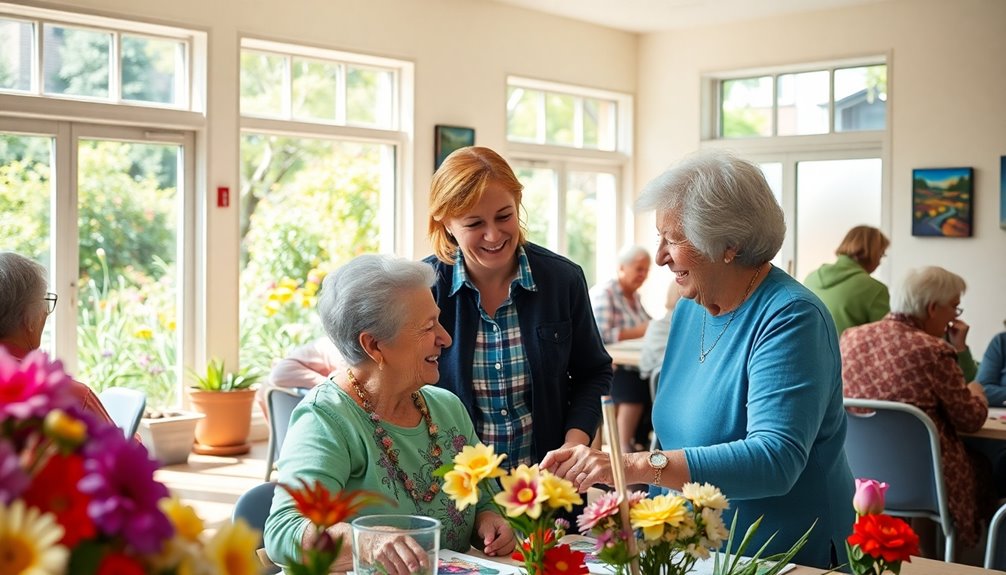
Community-based services play a vital role in enhancing the quality of life for older adults, especially as they age at home.
These services involve interdisciplinary teams of healthcare professionals, caregivers, social workers, and volunteers who provide comprehensive, tailored care. When team members collaborate effectively, you benefit from better health outcomes and increased satisfaction.
Community engagement fosters a sense of belonging and purpose, crucial for combating loneliness. Increased risk of depression and anxiety can be mitigated through accessible volunteer programs that enhance your involvement, creating strong social networks.
By improving access to healthcare services, community-based support helps manage chronic conditions and reduces hospitalization needs.
Functional Limitations and Their Impact on Aging in Place
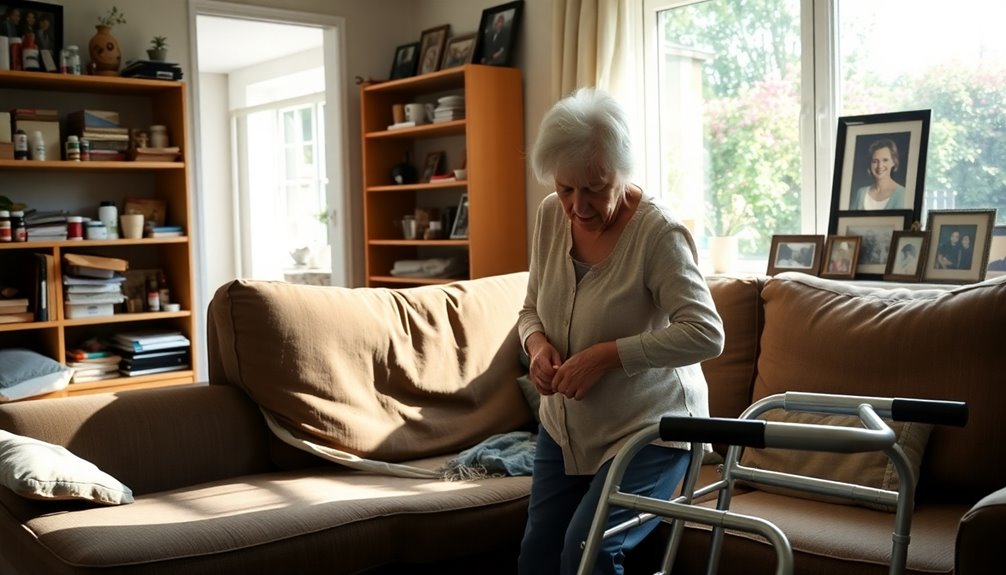
Functional limitations can significantly impact your ability to age in place, often affecting independence and overall well-being. As you age, the likelihood of experiencing physical limitations increases, especially if you're a woman or from certain demographic backgrounds. Disability prevalence rises with age, with 30% of individuals aged 65-74 experiencing some form of limitation, highlighting the importance of proactive health management. Additionally, early detection of health issues such as breast cancer can play a crucial role in maintaining your overall health as you age. These limitations can hinder your mobility and social engagement, leading to isolation and decreased quality of life. Moreover, the accumulation of chronic conditions intensifies this risk, making it crucial to address your health proactively.
While recent trends show some older adults encountering these issues later in life, the need for accessibility in your living environment remains. Planning modifications and implementing physical activity can help maintain your independence, but it's essential to recognize the challenges functional limitations pose as you age at home.
The Burden of Informal Caregiving

As you navigate the challenges of aging in place, the role of informal caregiving becomes increasingly significant. With around 53 million adult caregivers in the U.S., you're not alone in shouldering this responsibility.
Many caregivers, predominantly women, provide an average of 23.7 hours of care weekly, often at the expense of their own health and finances. The economic burden can be staggering, with costs ranging from $530 billion to $1.14 trillion annually. Approximately one-third of caregivers provide over 20 hours of care each week, emphasizing the overwhelming nature of these responsibilities. The lack of protective nail styles can also contribute to caregivers neglecting their own self-care, leading to further stress and health issues.
This strain can lead to lost productivity and shifts from full-time to part-time work, impacting your income. Additionally, about 40% of caregivers experience chronic conditions themselves, highlighting the urgent need for support and resources to help manage these overwhelming responsibilities effectively.
Access to Supportive Services: A Regional Disparity
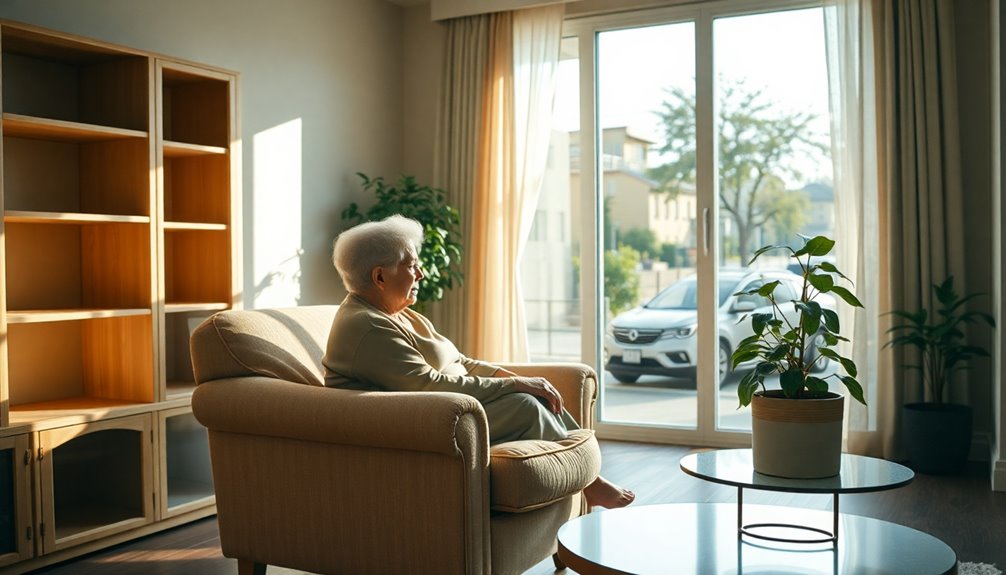
While navigating the complexities of aging at home, you may notice significant disparities in access to supportive services based on your location.
In rural areas, home health agencies often struggle with staffing challenges and long travel distances, which can delay care. Conversely, urban regions typically boast more resources and facilities, leading to higher rates of home health care utilization. You might find that those living in densely populated areas enjoy quicker access to services compared to their rural counterparts. Additionally, pet therapy can enhance emotional well-being for individuals in need of support, offering a valuable resource that may not be as easily accessible in certain regions.
Additionally, racial and socioeconomic factors further complicate accessibility, with low-income individuals facing hurdles in finding quality care. Understanding these regional disparities is crucial to making informed decisions about aging at home effectively. Furthermore, the increase in homebound individuals needing care due to the aging population highlights the importance of addressing these disparities.
Technology's Role in Home Care

Navigating the complexities of aging at home can be significantly enhanced by technology, which plays a pivotal role in improving care and support.
Telehealth services allow you to consult healthcare professionals remotely, minimizing in-person visits. Remote monitoring technologies facilitate timely health interventions, enhancing safety and independence for seniors through smart home systems. Additionally, incorporating HEPA filtration in air purifiers can improve indoor air quality, which is essential for the health of seniors.
Smart home systems automate tasks and enhance safety, creating a secure environment. Wearable devices monitor your vital signs and activity levels, providing critical data for health management. Voice-activated assistants promote independence by allowing hands-free control of your home. Fall detection systems alert caregivers in emergencies, while automated medication dispensers ensure you take the right doses on time.
With these innovations, you can enjoy a safer, more engaging, and supportive home environment, ultimately leading to a better quality of life as you age.
The Growing Demand for Long-Term Care Workers
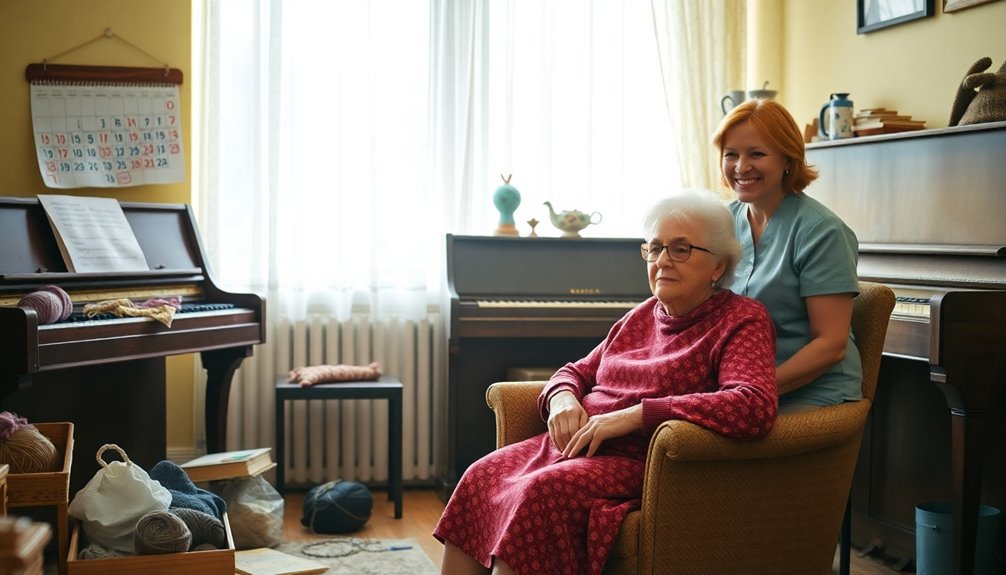
The increasing number of older adults in the U.S. creates an urgent need for long-term care workers, driven by a demographic shift that shows no signs of slowing down. By 2060, the population aged 65 and older is expected to reach nearly 89 million, with about 70% requiring some form of long-term care. This demand is projected to grow by 39% between 2022 and 2037, adding over 860,000 jobs in direct care. Additionally, the direct care workforce has increased significantly from 3.5 million in 2014 to over 5 million in 2023. However, challenges like high turnover rates and caregiver burnout complicate recruitment and retention efforts. To meet this growing need, the industry must implement workforce development strategies and specialized training programs to equip caregivers with the necessary skills for managing chronic conditions effectively.
Future Trends in Long-Term Care Services
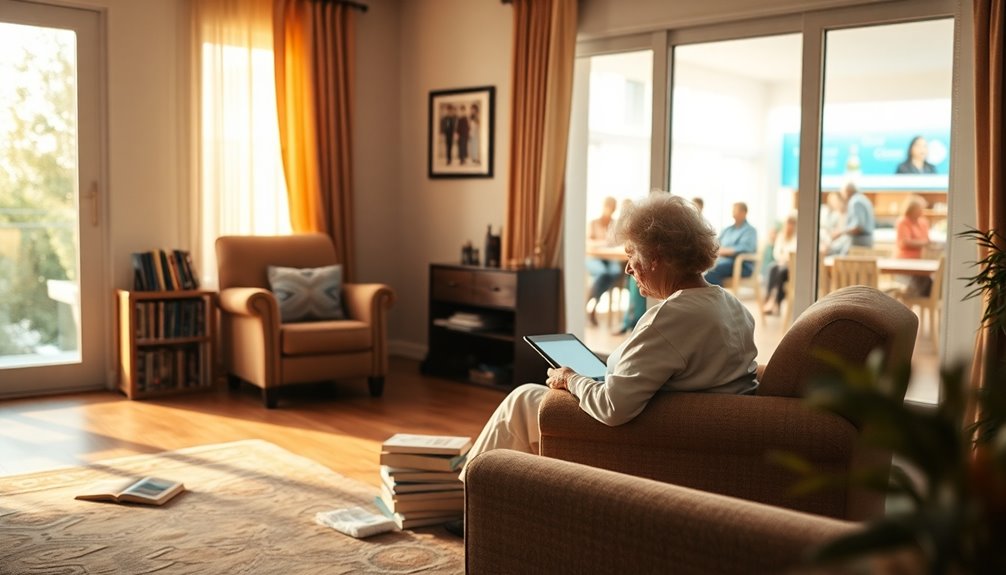
As the landscape of long-term care evolves, innovative technologies and new care models are reshaping how services are delivered to older adults.
Telehealth is expanding, allowing you to access healthcare from home through high-quality video consultations and remote monitoring. AI and machine learning personalize care plans and detect health issues early with smart sensors. Robotics assist with routine tasks, giving staff more time for patient care. Long-term care needs are projected to reach 27 million Americans by 2050, highlighting the urgent need for adapting our care systems. Additionally, heat pump technology can enhance home-based care by providing energy-efficient heating and cooling solutions, improving overall comfort for patients.
Meanwhile, virtual reality enhances rehabilitation. Care models are shifting to value-based approaches, focusing on patient outcomes and emphasizing preventive care and mental health services.
Home-based care is on the rise, enabling you to stay in your home longer, supported by multidisciplinary teams that ensure comprehensive care.
Frequently Asked Questions
What Are the Emotional Impacts of Aging at Home?
Aging at home can significantly impact your emotional well-being. You might experience social isolation, leading to loneliness and exacerbating mental health issues like anxiety and depression.
The loss of purpose after retirement can further affect your emotions. Additionally, inadequate support and risk of neglect can create feelings of vulnerability. This is compounded by financial stresses, especially for those waiting until 70 for benefits, which can heighten anxiety about future security. As individuals grapple with the uncertainty of their next steps, the weight of isolation can deepen, making it crucial to establish new social connections and activities. Ultimately, finding a renewed sense of purpose through exploration and meaningful engagement becomes essential for emotional well-being in the retirement phase.
On the flip side, strong emotional support from caregivers and engaging in meaningful social activities can help maintain a fulfilling life.
How Can I Ensure Safety in My Home for Aging?
Imagine your home as a fortress, protecting you as you age. To ensure safety, start by clearing clutter from pathways and installing grab bars in the bathroom.
Brighten each room with adequate lighting, especially near stairs. Consider non-slip mats and smart home devices to enhance your security.
Regularly reassess your space, inviting family or professionals to help identify potential hazards. With these steps, you're not just aging; you're thriving in your own castle.
What Are Alternatives to Traditional Home Care Services?
If you're considering alternatives to traditional home care services, you have several options.
In-home care offers personalized support while allowing you to stay in a familiar environment.
Assisted living communities provide housing and care in a supportive setting.
Adult day care centers offer socialization and supervision during the day.
Lastly, respite care can give your family caregiver a much-needed break.
Each option can help maintain your independence while ensuring you receive the care you need.
How Does Social Isolation Affect Older Adults Aging at Home?
Social isolation can significantly impact older adults aging at home. When you're isolated, your risk of chronic health issues, depression, and cognitive decline increases.
You might feel lonely, which can weaken your immune system and heighten mortality risks. Engaging with community activities and maintaining social connections is crucial for your mental and physical well-being.
What Role Do Pets Play in the Lives of Older Adults?
Pets are like warm blankets on a chilly day, wrapping you in comfort and companionship.
In your life as an older adult, pets play a vital role by reducing loneliness and enhancing emotional well-being. They encourage you to stay active, promoting both physical and mental health.
With a furry friend by your side, you're more likely to engage socially and enjoy a sense of purpose, making every day a little brighter.
Conclusion
So, while aging at home might seem like the best option, it's crucial to weigh the real challenges. From hidden costs to the burden on family caregivers, the reality can be tougher than it looks. Plus, don't forget about the importance of community services and tech advancements that can enhance care. As you plan for the future, remember: it takes a village, not just a cozy chair at home, to ensure a fulfilling aging experience.
References
- https://www.caregiver.org/resource/selected-long-term-care-statistics/
- https://opentextbc.ca/writingforsuccess/chapter/chapter-9-citations-and-referencing/
- https://aspe.hhs.gov/reports/trends-use-residential-settings-among-older-adults-issue-brief-0
- https://blog.propllr.com/how-to-do-content-research-for-blog-posts
- https://www.bls.gov/spotlight/2024/how-has-long-term-care-employment-changed-with-an-aging-u-s-population/
- https://www.nia.nih.gov/health/aging-place/aging-place-growing-older-home
- https://www.mdpi.com/1660-4601/17/8/2953
- https://choicemutual.com/blog/aging-in-place-statistics/
- https://easylivingfl.com/assisted-living/data-shows-that-aging-at-home-is-growing-heres-how-you-can-do-it/
- https://www.census.gov/newsroom/press-releases/2023/aging-ready-homes.html
